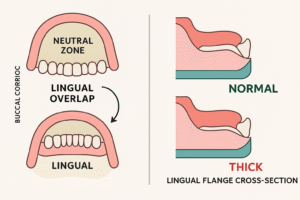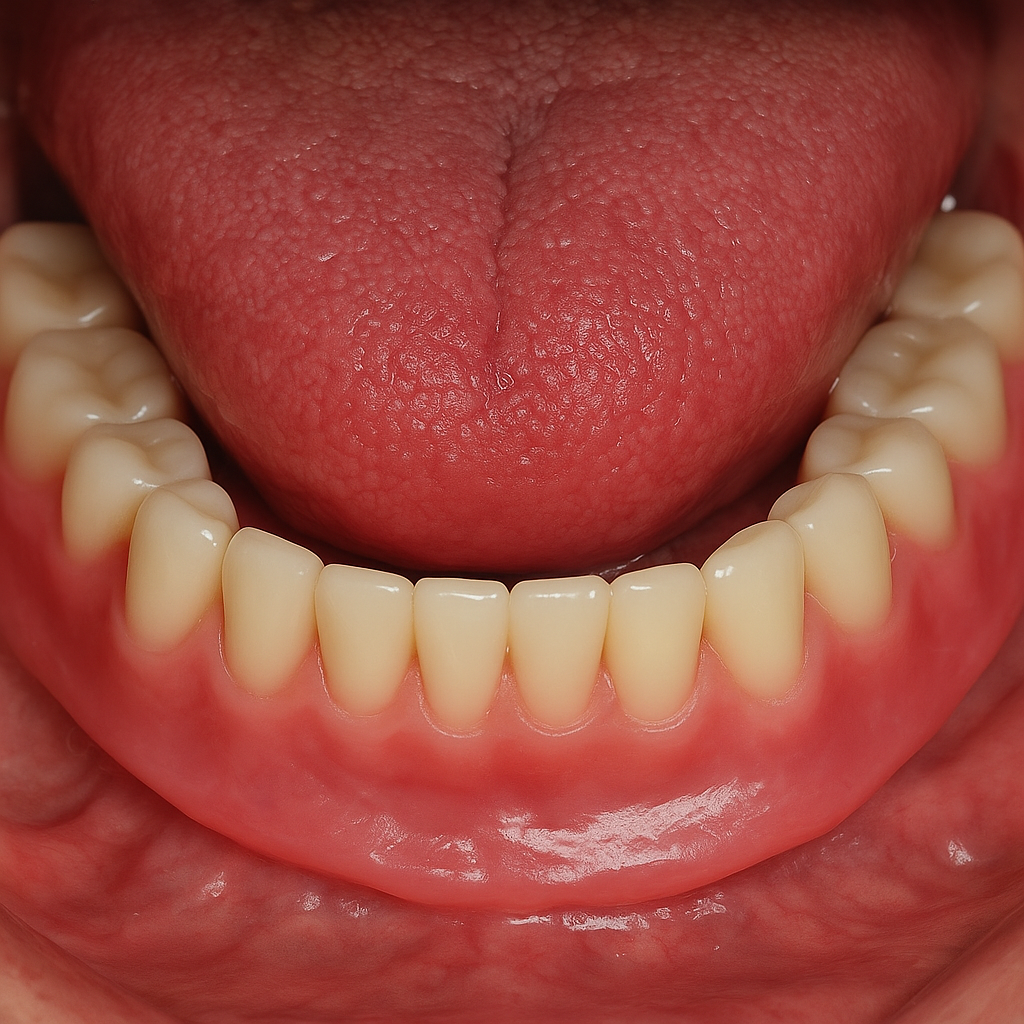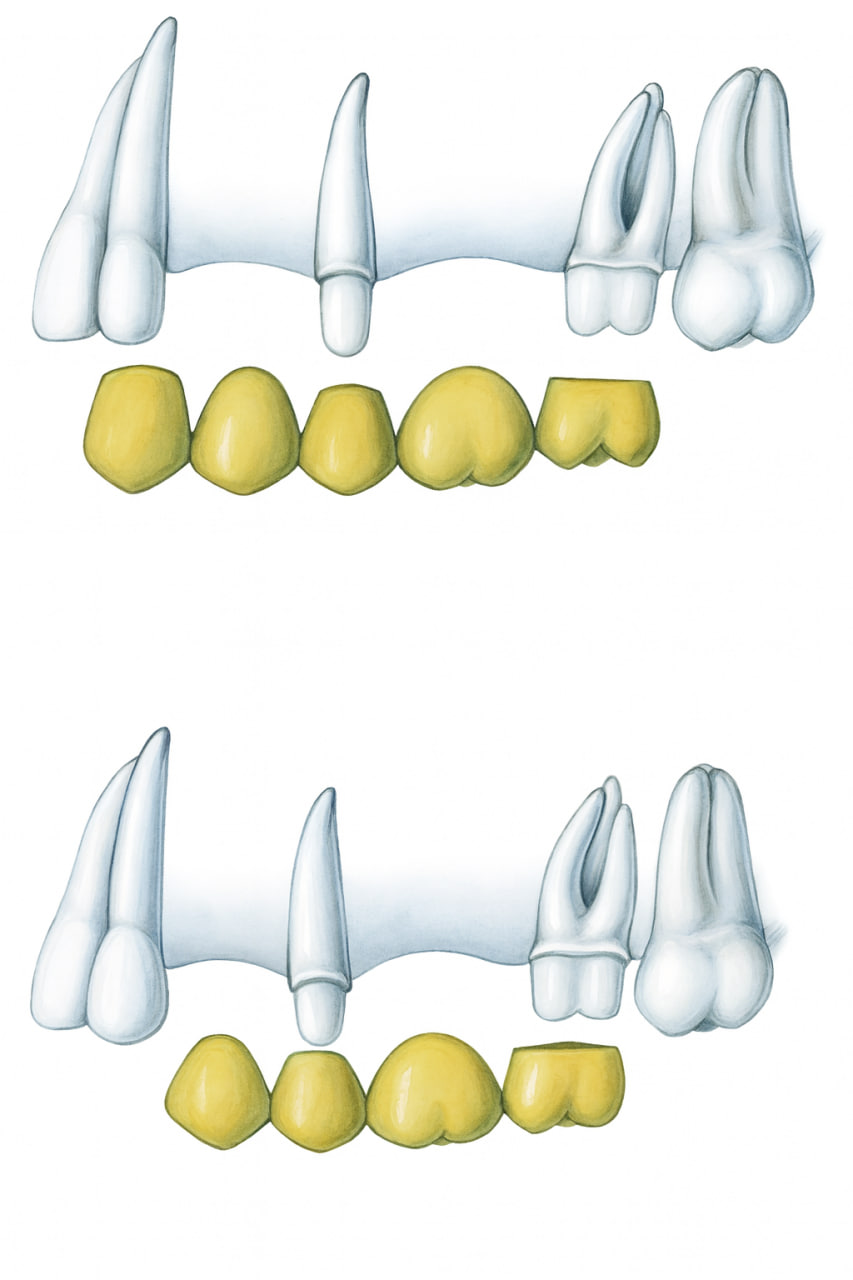Introduction of mandibular denture discomfort
Edentulous patients often return for post-insertion adjustments after receiving complete mandibular dentures or overdentures. While most concerns are related to stability, retention, or occlusion, a significant number report lingual discomfort ranging from mild irritation to ulcerations—due to contact between the tongue and the denture.
These symptoms can result from various mechanical, anatomical, or behavioral factors, making systematic diagnosis essential for effective management.
What are the Common Etiologies of mandibular denture discomfort
1. Lingual Placement of Mandibular Teeth Beyond the Neutral Zone
When mandibular artificial teeth are positioned lingually to the neutral zone, the denture may encroach on tongue space. This is often due to arranging teeth in reference to the maxillary arch without considering mandibular muscular dynamics. Such encroachment can lead to repeated tongue biting and chronic lateral border soreness (Zarb, McCracken).
2. Excessive Thickness of the Lingual Flange
Over-bulking of the lingual flange in the mandibular denture can compromise tongue space, hinder lingual mobility, and cause chronic mucosal irritation. This not only results in discomfort but also predisposes to food entrapment and phonetic difficulties, particularly with alveolar and lingual consonants.
Shillingburg emphasizes that optimal flange contour is a balance between maximizing denture stability and minimizing interference with oral musculature.
An overly thick lingual flange reduces tongue space, irritates the lingual mucosa, traps food, and impairs phonetics—particularly with lingual consonants. Proper flange contour is crucial for balancing stability with patient comfort.
3. Lack of Lingual Flange Concavity
The creation of a slight concavity along the lingual flange serves as a resting platform for the tongue, contributing to enhanced mandibular denture stability through neuromuscular control. Failure to incorporate this contour reduces stability and increases the likelihood of lateral tongue wall irritation.
Evidence from studies on denture biomechanics supports that the lingual flange should harmonize with the sublingual crescent area to utilize tongue pressure for retention rather than resistance.
A slight concavity in the lingual flange acts as a tongue rest, improving denture stability through neuromuscular control. Without it, stability is compromised and irritation along the lateral tongue is more likely.

4. Improper Lingual Surface Contouring During Denture Base Finishing
The lingual base should fill the papillary spaces smoothly without creating niches for food accumulation. Poor contouring not only causes mechanical irritation but also increases plaque retention and halitosis risk.
5. Inadequate Polishing of Lingual Surfaces
Any surface roughness, whether from insufficient laboratory polishing or irregularities introduced during chairside relining, can abrade the tongue mucosa. This is particularly problematic in the lingual flange or lingual surfaces of the denture teeth, where repetitive friction during speech and mastication can perpetuate soreness.
6. Parafunctional Tongue Activity in Response to a New Prosthesis
In some cases, tongue discomfort is not directly due to overextension or roughness, but rather to hyperactivity of the tongue as it adapts to the presence of a new prosthesis. This is a transient phenomenon, generally subsiding within weeks as neuromuscular adaptation occurs, and should be distinguished from true mechanical trauma.
7. Pre-existing Pathology of the Lateral Tongue Border
Lesions such as aphthous ulcerations, lichen planus, or traumatic keratoses may cause hypersensitivity, making even gentle contact with the lingual flange uncomfortable. In such cases, management should address the underlying mucosal pathology alongside denture adjustments.
8. Low Threshold for Prosthetic Tolerance
Some patients exhibit a heightened awareness or low tolerance to minor irregularities in their prosthesis. Here, the subjective severity of symptoms may be disproportionate to objective findings. Effective management requires both technical correction of any genuine issues and behavioral strategies to improve adaptation.
Conclusion of mandibular denture discomfort
Lingual discomfort in mandibular dentures is often multifactorial. A step-by-step approach—evaluating tooth positioning, flange thickness, flange concavity, base contour, surface finish, mucosal health, and patient adaptation—ensures precise diagnosis and targeted treatment.
Respecting the neutral zone and optimizing flange contour remain fundamental in preventing tongue-related complications in complete denture therapy. for more dental articles visite our blog.




